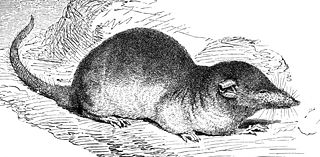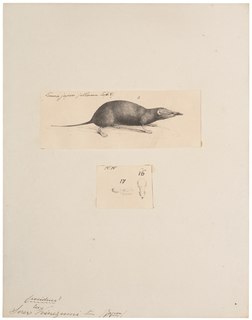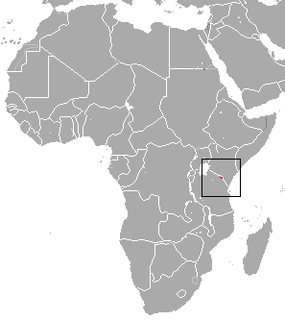
The white-toothed shrews or Crocidurinae are one of three subfamilies of the shrew family Soricidae.

The genus Crocidura is one of nine genera of the shrew subfamily Crocidurinae. Members of the genus are commonly called white-toothed shrews or musk shrews, although both also apply to all of the species in the subfamily. With over 180 species, Crocidura contains the most species of any mammal genus. The name Crocidura means "woolly tail", because the tail of Crocidura species are covered in short hairs interspersed with longer ones.

The Dsinezumi shrew, also known as the Japanese white-toothed shrew, is a species of musk shrew found in Japan and on Korea's Jeju Island. It is widespread, and considered to be of "least concern" by the IUCN.

The Ussuri white-toothed shrew is a species of musk shrew found on the mainland Northeast Asia. It is common and widespread, and is one of the largest shrews found in the region, with adult weight of 14–25 g (0.49–0.88 oz). It should not be confused with the related Ussuri shrew.

The Cyrenaica shrew or Alexander's shrew is a species of white-toothed shrew in the family Soricidae which is endemic to Libya.

Bates's shrew is a species of mammal in the family Soricidae. It is found in Cameroon, Republic of the Congo, Equatorial Guinea, and Gabon. Its natural habitat is subtropical or tropical moist lowland forests. This large black shrew was first described by the British zoologist Guy Dollman in 1915, the type locality being the vicinity of the Como River in Gabon. The exact definition of this species is unclear; it is often included in Fraser's musk shrew, or reported as Wimmer's shrew. Its karyotype is 2n=50, FN-76, which is identical to the Nigerian shrew, and the species complex is in need of a thorough revision.

Doucet's musk shrew is a species of mammal in the family Soricidae. It is found in Ivory Coast, Liberia, and possibly Nigeria. Its natural habitat is subtropical or tropical dry forests.

The Peters's musk shrew is a species of mammal in the family Soricidae. It is endemic to Tanzania.

The Sulawesi shrew is a species of mammal in the family Soricidae. It is endemic to the central and northern provinces of Sulawesi in Indonesia. It is a fairly common species and the International Union for Conservation of Nature has assessed its conservation status as being of "least concern".

The swamp musk shrew, or musk shrew, is a species of mammal in the family Soricidae. It occurs in Angola, Botswana, Democratic Republic of the Congo, Mozambique, Namibia, South Africa, Eswatini, Zambia and Zimbabwe. Its natural habitat is swamps, and it is a common species in suitable habitats, with the International Union for Conservation of Nature listing it as being of "least concern".

The African giant shrew is a species of white-toothed shrew. It also is known as, Mann's musk shrew, Euchareena's musk shrew, or Olivier's shrew. It is native to Africa, where it has a widespread distribution and occurs in many types of habitat. Its natural habitats are subtropical or tropical dry forest, subtropical or tropical moist lowland forest, subtropical or tropical moist montane forest, dry savanna, moist savanna, arable land, rural gardens, urban areas, and heavily degraded former forest. In the Nile Valley it is found near human habitation, where it is considered to be a pest. It is a common species and is listed by the International Union for Conservation of Nature as being of "least concern".

Fraser's musk shrew is a species of mammal in the family Soricidae. It is found in Benin, Cameroon, Ivory Coast, Equatorial Guinea, Ghana, Guinea, Liberia, Nigeria, São Tomé and Príncipe, Sierra Leone, and Togo. Its natural habitat is subtropical or tropical moist lowland forests. This large black shrew was first described by the British zoologist Louis Fraser in 1843. Its exact definition is unclear; the karyotype comes from Ivory Coast but not from Equatorial Guinea, which is given as the type locality.

The Egyptian pygmy shrew or sacred shrew is a species of mammal in the family Soricidae. It is endemic to Egypt. Its natural habitat is arable land. It is threatened by habitat loss, partially caused by the construction of the Aswan Dam. They are 48–62 mm (1.9–2.4 in) in length and weigh 7 g (0.25 oz), making them one of the smallest shrews in Egypt.

Whitaker's shrew is a species of mammal in the family Soricidae. It is found in Western Sahara, Algeria, Morocco, Tunisia. Its natural habitats are subtropical or tropical dry shrubland, rocky and sandy coasts. It is a fairly common species and the International Union for Conservation of Nature has rated its conservation status as being of "least concern".

The Christmas Island shrew, also known as the Christmas Island musk-shrew is an extremely rare or possibly extinct shrew from Christmas Island. It was variously placed as subspecies of the Asian gray shrew or the Southeast Asian shrew, but morphological differences and the large distance between the species indicate that it is an entirely distinct species.















